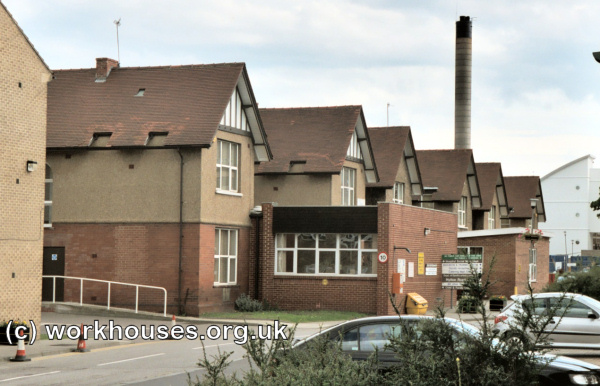Sunderland Council Homes
In 1930, the Boards of Guardians, who had administered the poor relief system in England and Wales since 1834, were abolished and their responsibilities were taken over by county and county borough councils. Each council set up a Public Assistance Committee to oversee its new duties, which included the operation of the various children's establishments previously run by the poor law unions in each area. The Sunderland Council's Public Assistance Committee took over the Sunderland Union's Highfield Cottage Homes at 235 Hylton Road, Sunderland, where 153 children could be housed, and the nearby home for 38 boys at Havelock Tower, 188 Hylton Road.

Highfield Cottage Homes, Sunderland, 2002.
© Peter Higginbotham.
In 1945, the council was running nine wartime nurseries. One of these, at Hexham Villa, Birtley, continued in operation as a residential nursery for many years after the war.
Following the passing of the 1948 Children Act, councils were required to provide care services for all needy children in their area, especially those who lacked a normal family home. In common with other local authorities, the council established a new Children's Committee, whose responsibilities had previously been spread across separate Health, Education and Public Assistance Committees. The Committee took over responsibility for the existing homes on Hylton Road. The council also gained responsibility for the Girls' Remand Home at Church Street, Seaham. The following year, 1949, saw the opening of a hostel for working boys at 14 The Esplanade West, Sunderland, and a residential nursery at Burdon Hall, Bishopton Lane, Darlington. In 1950, a reception hostel was opened at Ashbrooke Towers, Alexandra Road, Sunderland. By 1953, a hostel for working girls was in operation at 3 The Esplanade, Sunderland.
The 1948 Act had recommended that where children needed to be in residential care, they should be in homes, which ideally accommodated no more than eight children, or twelve at most. In the mid-1950s, Sunderland began to adopt this policy with the gradual opening of eight small 'family group' homes, each providing ten places, located on new council housing estates being built around the city. The first of these were at 12 Godfrey Road, 17 Goodwood Road, and 59 Cotswold Road, all on the Grindon Village estate. By 1958, they had been joined by 8 Anthony Road and 9 Aston Square, both at East Herrington. The final additions in around 1960 were at 12 Toronto Road, 24 Rennie Road, 18 Revelstoke Road and 7 Columbo Road. The completion of this building programme allowed the closure of the old cottage homes on Hylton Road to take place. At around the same time, the working boys' hostel on Esplanade West was relocated to 15 Thornhill Park, Sunderland. The working girls' hostel then moved to the former boys' premises, while its own building at 3 The Esplanade became another children's home. In 1971, the Burdon Hall nursery moved to a site of Viewforth Road, Carley Hill.
The council's children's accommodation in 1972 is listed below:
| Location | Places |
|---|---|
| Reception Hostel, Ashbrooke Tower, Alexandra Road, Sunderland | 25 |
| Carley Hill Residential Nursery, Off Viewforth Terrace, Sunderland | 15 |
| 3 The Esplanade, Sunderland | 18 |
| 12 Godfrey Road, Grindon Village | 10 |
| 17 Goodwood Road, Grindon Village | 10 |
| 12 Toronto Road, Thornley Close, Sunderland | 10 |
| 18 Revelstoke Road, Sunderland | 10 |
| 24 Rennie Road, Sunderland | 10 |
| 59 Cotswold Road, Sunderland | 10 |
| 7 Columbo Road, Sunderland | 10 |
| 8 Anthony Road, East Herrington, Sunderland | 10 |
| 9 Aston Square, Sunderland | 10 |
| Hostel for Working Boys, 15 Thornhill Park, Sunderland | 18 |
| Hostel for Working Girls, 14 The Esplanade West, Sunderland | 18 |
| Greystones Remand Home for Girls, Church Lane, Seaham | 16 |
| Location |
|---|
| 9 Aston Square, Sunderland |
| 98 Avenue Vivian, Fencehouses |
| 12 Godfrey Road, Grindon Village |
| 17 Goodwood Road, Grindon Village |
| 12 Toronto Road, Thornley Close, Sunderland |
| 18 Revelstoke Road, Sunderland |
| 24 Rennie Road, Sunderland |
| 59 Cotswold Road, Sunderland |
| 7 Columbo Road, Sunderland |
| 131 Coach Road Estate, Washington |
| Gilpin House, Blind Lane, Houghton-le-Spring |
| Thorncliffe, Home for Adolescent Boys, Newcastle Road, Boldon |
| Children's Centre Residential Unit, Durham Road, Sunderland |
| Witherwack House Individual Care Unit, Woolwich Road, Witherack |
| Penshaw House Community Home, Station Road, Penshaw |
| Wellesley Community School, Links Road, Blyth |
| Holmewood Independent Unit for Young Persons, 14 The Esplanade West, Sunderland |
| Emsworth House Assessment Centre, Emsworth Road, Sunderland |


